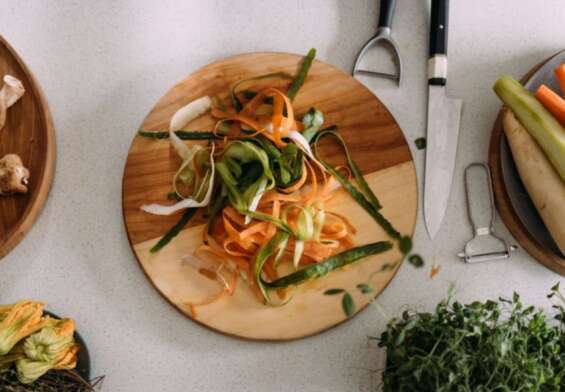
Low Carbon Diet: How Food Choices Impact the Environment
A low carbon diet is a way of reducing your carbon footprint on the planet by changing what and how you eat. It involves consuming foods that require less energy to produce, process, and transport, resulting in a lower overall carbon output. This includes eating more plant-based foods and reducing reliance on animal products, as well as eating more locally-sourced foods and reducing food waste. Low carbon diets can make a significant contribution to reducing the effects of climate change, and are an important step in creating a more sustainable food system.
How to Create a Low-Carbon Diet: Tips and Tricks
Start off small by eating less red meat – it’s not only better for your health, but it’s also better for the planet!
Swap out processed snacks for fresh fruit and veggies. Not only are they packed with nutrition, they don’t come with a hefty carbon footprint.
Reuse and recycle leftovers with creative recipes. A little bit of creativity can go a long way in reducing food waste and your carbon footprint.
Shop local when you can. Supporting local farmers helps reduce transportation emissions and keeps your food miles low.
Try a meatless Monday. It’s a great way to cut down on your carbon emissions and get a few extra servings of veggies.
Use reusable shopping bags. You can save hundreds of plastic bags from ending up in the landfill every year!
Try to buy organic when possible. It may cost a little bit more, but it helps keep harmful pesticides out of the environment.
Have a little fun with it! Try some of the latest plant-based food trends like jackfruit tacos or a vegan burger.
Lastly, don’t forget to compost. Composting helps reduce food waste and turns it into a nutrient-rich soil amendment.
The Benefits of Eating a Low-Carbon Diet
If you’re looking for a way to reduce your carbon footprint, why not start with your diet? Eating a low-carbon diet is a great way to help the environment and keep your waistline trim. Here are some of the benefits of going low-carbon:
Go Green: Eating a low-carbon diet means you’ll be eating more plant-based foods. That means more veggies, fruits and grains, and fewer animal products. And, of course, less red meat, which is one of the biggest contributors to climate change.
Keep Your Carbon Footprint in Check: Eating a low-carbon diet helps you reduce the amount of carbon dioxide emissions you’re responsible for. That means you’ll be helping the environment without even trying!
Save Money: Eating plant-based foods is often cheaper than buying animal products. So, you can save money while also doing your part to help the planet.
Get Creative: Eating a low-carbon diet means you’ll have to get creative in the kitchen. You’ll be trying out new recipes and finding ways to make delicious meals without using animal products.
Feel Good: Eating a low-carbon diet can make you feel good about yourself. Knowing you’re doing your part to help the environment can be a great feeling. Plus, you’ll be eating healthier and feeling better overall.
Eating a low-carbon diet isn’t just good for the environment – it’s good for you too! So, why not give it a try? You’ll be helping the planet and your waistline at the same time.
How to Reduce your Carbon Footprint by Eating a Low-Carbon Diet
Are you looking for ways to reduce your carbon footprint? Well, we have a solution for you – a low-carbon diet! No, it’s not a diet where you eat only lettuce and carrots, but you will be eating food that produces less carbon emissions. Here are our top tips for eating a low-carbon diet:
Go for plant-based options – Eating plant-based food produces fewer carbon emissions than eating animal-based products. So, if you’re looking for a tasty and low-carbon meal, why not go for a vegan burger instead of a beef one?
Buy local – Shopping locally is a great way to reduce your carbon footprint. The food you buy has to travel less to get to your plate, so it emits fewer emissions. Plus, buying local also supports small businesses in your community.
Use the power of the sun – If you’re serious about reducing your carbon footprint, why not invest in a solar oven? It uses the power of the sun to cook your food, meaning no gas or electricity is used in the process.
Buy in bulk – If you buy in bulk, you’ll be reducing the amount of packaging you use. That means fewer emissions from the production of the packaging materials. Plus, you’ll be saving money too!
Compost your food waste – Don’t throw away your food scraps! Compost them instead. This is a great way to reduce your carbon footprint, as composting eliminates the need for your food waste to be transported to a landfill.
Eating a low-carbon diet doesn’t have to be boring. With a little creativity and these five tips, you can easily reduce your carbon footprint and enjoy tasty food at the same time. So what are you waiting for? Get started on your low-carbon journey today!
The Environmental Impact of Eating a Low-Carbon Diet
Eating a low-carbon diet isn’t just good for your waistline – it’s also great for the environment! But what exactly is a low-carbon diet and how can it help to reduce the carbon footprint of your food choices?
Well, a low-carbon diet is one that is focused on choosing foods that have a lower carbon footprint, meaning they require fewer resources like energy and water to produce. This means opting for plant-based proteins like beans and lentils, as well as fresh fruits and vegetables that are locally sourced and in-season. And of course, cutting out processed and packaged foods can also help to reduce your carbon footprint.
So, what are the environmental benefits of eating a low-carbon diet? Well, first and foremost, it can help to reduce greenhouse gas emissions from the food sector, which is one of the largest contributors to global warming. In addition, it can help to reduce water and energy usage, as well as land and water pollution associated with the production of certain foods.
Plus, it can also benefit wildlife, as many plant-based foods require less land to produce, meaning there is more land available for wildlife to inhabit.
So, if you’re looking to do your part to help the environment, why not try out a low-carbon diet? It’s a delicious way to reduce your carbon footprint – and you’ll be doing your part to save the planet, one bite at a time!
How to Source Local, Sustainable Foods for a Low-Carbon Diet
If you’re looking for ways to reduce your carbon footprint and eat sustainably, you can start by sourcing local food. Eating locally-sourced food is one of the most effective ways to reduce your environmental impact. And, lucky for you, it can be a delicious and fun journey!
First, you’ll need to find out what’s in season and available in your area. Check with local farmers markets and farm stands to see what they have to offer. You may even find some unique, locally-grown produce that you never knew existed!
If you don’t have access to a farmers market, try checking out your local grocery store. Many grocery stores now carry local produce, especially in the summer months. Keep an eye out for locally-grown fruits and vegetables, as well as eggs, dairy, and meat products.
You can also look for restaurants that serve locally-sourced food. Many restaurants proudly list their local suppliers on their menus and websites. Plus, it’s always nice to support local businesses.
Finally, if you want to go the extra mile, look for foods that are certified organic and/or certified humane. These labels guarantee that the food has been grown or raised in a sustainable way.
Eating local, sustainable foods is a great way to reduce your carbon footprint while still enjoying delicious meals. And with a little bit of research and effort, you can find plenty of local, sustainable food options that will leave your taste buds and your planet happy.
Plant-Based Eating: Key to a Low-Carbon Diet
If you’re looking for a way to reduce your carbon footprint, there’s no better way than to switch to a plant-based diet! It’s the ultimate green makeover — no more burgers and steaks, just endless delicious plant-based dishes.
Sure, the prospect of a plant-based diet can seem daunting — after all, it’s hard to imagine giving up your favorite comfort foods. But just think of all the amazing flavors and textures you’ll get to explore! From hearty bean stews to creamy mushroom risottos, there’s something to suit every palate. And if you’re still missing the taste of meat, there are plenty of plant-based alternatives that offer the same flavors and textures.
Plus, a plant-based diet has numerous health benefits. Eating more fruits and vegetables is associated with a reduced risk of chronic diseases such as diabetes, heart disease, and cancer. And since plants require far less energy to produce than animal products, your low-carbon diet also means a low-impact lifestyle.
So go ahead and give plant-based eating a try! You’ll be helping the planet, your health, and your taste buds — all at the same time!
Shopping Smart for a Low-Carbon Diet: Tips and Tricks
- Shop local: Shopping local not only supports your local economy, it also reduces your carbon footprint by reducing food miles.
- Buy in bulk: Buying in bulk can help you save money and reduce packaging waste.
- Eat seasonal: Eating seasonal produce is a great way to reduce your carbon footprint. Eating seasonal produce also means you get to enjoy the freshest and tastiest produce available.
- Go organic: Organic farming is better for the environment because it works with nature and avoids using synthetic pesticides, herbicides, and fertilizers.
- Choose sustainable seafood: Choose sustainable seafood that is caught using methods that are less damaging to the environment, such as pole and line fishing, or trolling.
- Bring your own bags: Bring your own reusable bags when you go shopping to reduce the amount of plastic waste you generate.
- Avoid food waste: Buy only what you need and use what you have. Food waste is a huge contributor to global warming.
- Shop the perimeter: Shop the perimeter of the store for fresh produce, meat, and dairy. The inner aisles tend to be filled with packaged and processed foods that are often high in sugar, fat, and sodium and have a high carbon footprint.
- Buy in bulk when you can: Bulk buying can help you save money and reduce packaging waste.
- Have fun: Shopping smart for a low-carbon diet can be fun and rewarding. Have fun experimenting with new recipes and exploring new foods.
Reducing Food Waste and Eating a Low-Carbon Diet
Did you know that reducing food waste and eating a low-carbon diet can help you save the planet? It’s true! It’s the two-step dance to environmental sustainability!
First, let’s tackle reducing food waste. Food waste is a huge issue around the world – it’s estimated that one-third of the food produced is lost or wasted. So, how do we reduce it?
Well, here are a few tips:
- Don’t be afraid of leftovers! Leftovers can be a great way to reduce food waste. Just heat them up, mix them up, or dress them up – whatever you do, make sure you enjoy them!
- Buy in bulk, but don’t buy too much. It’s great to buy in bulk, but don’t buy too much food. If you’re going to buy in bulk, make sure you have a plan for what you’re going to do with the extra food before you buy it.
- Compost your food scraps. Composting your food scraps is a great way to reduce food waste – and it’s good for the environment, too!
- Now, let’s talk about eating a low-carbon diet. Eating a low-carbon diet means eating fewer animal products and more plant-based foods. This is because animal-based foods require more energy and resources to produce.
Here are a few tips to get you started:
- Eat more plant-based proteins. Beans, legumes, nuts, and seeds are all great sources of protein that are low in carbon.
- Try out some new grains and vegetables. There are so many delicious grains and vegetables out there – why not give them a try?
- Enjoy some low-carbon treats. There are plenty of low-carbon treats out there, like dark chocolate and frozen yogurt.
So, there you have it – reducing food waste and eating a low-carbon diet are the two-step dance to environmental sustainability. So get out there and give it a whirl!
The Benefits of Eating Seasonally for a Low-Carbon Diet
Are you looking to reduce your carbon footprint while still getting all your essential nutrients? Look no further – eating seasonally is the answer! Here are some top benefits of eating seasonally for a low-carbon diet:
More Nutritious: Eating seasonally means you’ll be getting the freshest produce available, which is also the most nutrient-dense. It’s like getting a vitamin boost with every meal!
More Flavorful: Eating seasonally means you’ll get the most flavorful produce available since it hasn’t been stored for long periods. When fruits and vegetables are harvested at peak ripeness, they’re naturally packed with flavor!
Less Food Miles: Eating seasonally means you’re not supporting the transport of produce from far away places, reducing your carbon footprint. It’s like a local food group hug for the environment!
More Affordable: Eating seasonally means you’ll save money since produce that’s in season is typically cheaper and more plentiful. And who doesn’t love a good bargain?
More Variety: Eating seasonally means you’ll get to try new fruits and vegetables you’ve never tasted before. It’s like a culinary adventure every time you shop!
So, if you’re looking to reduce your carbon footprint and eat healthier, look no further than eating seasonally. Enjoy the flavor, nutrition, and money-saving benefits of eating seasonally – it’s a win-win for you and the environment!
How to Make Low-Carbon Diet Meals on a Budget
Tired of breaking the bank while trying to eat low-carbon meals? We’ve got you covered! Here are some helpful tips to make eating low-carbon meals on a budget a breeze.
Bulk up your meals. Buying in bulk can make eating low-carbon meals much more affordable. Look for staples like legumes, grains, and nuts in bulk bins at your local grocery store.
Don’t forget the frozen aisle. Frozen produce is usually more affordable and just as nutritious as fresh. Plus, it has a much longer shelf life, so you don’t have to worry about wasting food.
Get creative with leftovers. Turn last night’s dinner into tomorrow’s lunch. You can also freeze leftovers for easy meals down the road.
Get to know your pantry. Get creative with what you already have on hand. For example, try making a stir-fry with whatever veggies and grains are in your pantry.
Eat seasonally. Eating in-season produce is usually cheaper and often more nutritious. Plus, it helps reduce your carbon footprint.
Buy whole foods. Opt for whole foods like potatoes, squash, and onions instead of pre-cut and pre-packaged options. It’s cheaper and you’re reducing unnecessary packaging waste.
Grow your own food. Plant a garden and start growing your own food. You don’t need a lot of space – even a few pots on your balcony can do the trick.
With these tips, eating low-carbon meals on a budget is a piece of cake! Bon appetit!
Understanding the Carbon Impact of Different Foods: Key to a Low-Carbon Diet
Are you tired of trying to eat a low-carbon diet but not sure where to start? It can be daunting to figure out which foods have the lowest impact on the environment. But don’t worry, you don’t have to make a drastic change to your diet overnight! Here’s a quick guide to understanding the carbon impact of different foods, with a splash of humor to get you motivated.
Let’s start with the good news: Plant-based proteins like beans, lentils, and nuts are some of the lowest carbon-emitting food items. Not only are they naturally low in emissions, but they also often require less energy to produce than other sources of protein. So next time you’re in the grocery store, stock up on these items for a guilt-free, eco-friendly meal.
Now for the not-so-good news: Meat and dairy products are some of the most carbon-intensive foods out there. Beef, for example, produces up to 105 kg of CO2 per kg of product, while cheese produces up to 50 kg of CO2 per kg of product. Yikes! So if you’re looking to reduce your carbon footprint, consider reducing your intake of these items.
Finally, let’s talk about the grey area: Processed and packaged foods. These items can be tricky to categorize because they often contain a mix of both carbon-heavy and carbon-light ingredients. For instance, packaged snacks like chips and cookies may contain some plant-based proteins, but they also often contain a lot of oil and sugar, which can be carbon-heavy.
So there you have it: A basic guide to understanding the carbon impact of different foods. Now that you know how to make smarter choices in the grocery store, you can start eating a low-carbon diet without breaking a sweat!
Conclusion
The Low Carbon Diet is a great way to reduce your carbon footprint and help the environment. It encourages us to take a more sustainable approach to our food choices, which can help reduce our environmental impact. By reducing our consumption of animal products and focusing on plant-based sources of food, we can reduce our carbon emissions and help protect the planet. We can also support local producers and reduce the distance our food travels, reducing the emissions associated with food transportation. Taking a Low Carbon Diet can be a great way to reduce our carbon emissions and make a positive contribution to the environment.











